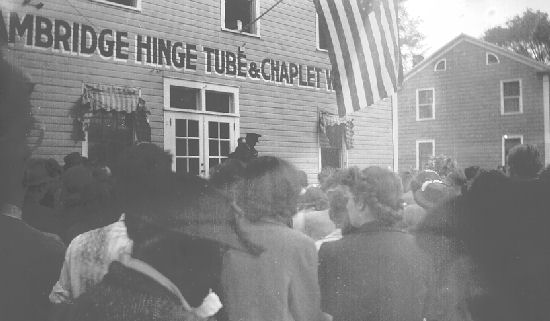|
Cambridge Hinge Tube and Cambridge Shirt Manufacturer
This
building was used to assemble the chaplets. Old fashioned hinges
were made of a hollow tube into which was placed a cylindrical core
... or something like that. I think the actual foundry work was done
at the building on the east side of Route 313 just south of the
junction of 313 and East Main Street (behind McLenithan's farm).
This was the old Lovejoy factory where they made the Cambridge Plow
in the late 1800s. |
|
|
|
|

Photo
I took in 1943, probably in June. That was a war year and companies
that were efficient in supporting the industrial war production were
given an "E" Award. It was on this occasion that I took the photo.
Note sign, flag and the Army Officer giving the Award. Submitted by Kirk Spurr, Class of 1948.
|
MORE CONVERSATION: Terry Granger class of 1968. I enjoyed reading the article regarding the Old Chaplet Works. It brought back some fond memories. My father, Floyd ( Sonny) Granger, my mother, Dorothy (Betty Dawley) Granger, and my uncle, John Dawley worked at the Cambridge Hinge Tube and Chaplet Works many years ago. I remember them working in the building across from Stewart's in the 50's and 60's. I believe that in the late 60's or early 70's the assembly of the hinge tubes was moved to the train station depot near the Hotel Cambridge. I also remember my parents bringing home hinge tubes and the family assembling them at the kitchen table. Thanks for the memories.
Bob Wright '56 Ed was very impressed with the machines capability to accomplish a number of bends in a single movement. The tubes were mounted in collars by hand. This work was done by a number of people in Cambridge on a piece work basis. Boxes of the two items were taken home and put together on the kitchen table after supper at night. The hinge tubes were used when furnace and wood stoves were cast out of iron and steel. Resin coated sand was packed into the tubes to create a hole in the casting of a stove. The sand was removed from the hole after the casting cooled to leave an accurate hole for pins or bolts to enter thereby completing the door hinge. To see a picture and description go to Chaplets/Smelko.com, than to Chaplets/Smeko Products Ltd. Scroll down to the bottom of the page to see what the Cambridge hinge tubes looked like.
|
|
COMMENTS |
|